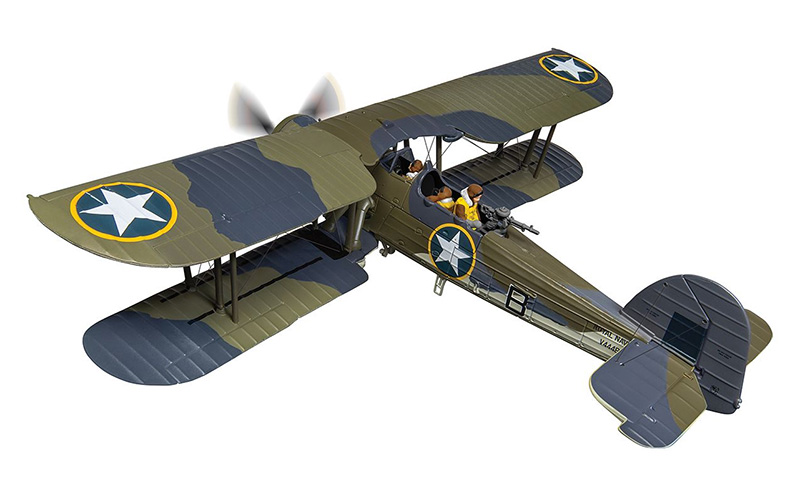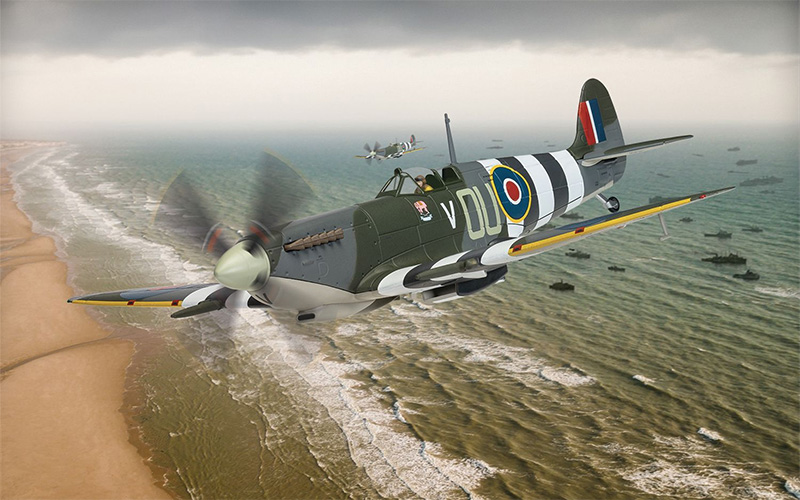Messerschmitt Me109G-6 Trop - Maggiore Antonio VizzottoRegia Aeronautica, 150 Gruppo, Sicily, July 1943 Just as the famous Fokker Eindecker had previously done during the Great War, the Messerschmitt Bf 109 would re-define aerial warfare and was an aircraft which was intended to dominate the sky. An aircraft which incorporated all the latest technological developments the aviation world had to offer, this project may have advanced as a lightweight monoplane fighter, but possessed the one attribute all hunting aeroplanes needed, and that was great speed. Produced in response to a Reich Aviation Ministry requirement for an advanced single-seat fighter aircraft, the design submitted by Bayerische Flugzeugwerke was radical in the extreme, diminutive and lightweight in construction and utilising the most powerful in-line aero engines in development in Germany at that time.Taking much of its design inspiration from the successful Messerschmitt Bf108 Taifun four-seat sports touring aircraft which preceded it, the Bf 109 was a relatively small, yet powerful monoplane fighter, one which was incredibly fast, heavily armed and highly manoeuvrable. At a time when the world's major air forces were mainly equipped with biplane designs for their front line fighter force, you might think that German pilots were desperate to get their hands on an aircraft which was so advanced that it was at the very forefront of world aviation, but that didn't initially prove to be the case. As they were used to slower, highly manoeuvrable aircraft with open cockpits, the enclosed cockpit of the Messerschmitt Bf 109 must have been more than a little claustrophobic for them, however, they soon warmed to the many impressive qualities of this aviation phenomenon, an aircraft which would allow them to dominate the skies. Interestingly, due to the advanced nature of the design and the fact that the new German built powerplants were not ready, the prototype aircraft was actually powered by a British Rolls Royce Kestrel engine, something of a strange dichotomy for a fighter which would go on to become the scourge of the Royal Air Force.Proving successful during flight trials with competing rival aircraft from other famous German aircraft manufacturers, the Messerschmitt Bf 109 would eventually enter service in 1937, a time where it's interesting to note that the Royal Air Force were just withdrawing their Bristol Bulldog biplane fighter from service and introducing the Gloster Gladiator, with the Luftwaffe clearly holding a significant technological advantage at that time. Nevertheless, even in Britain, the winds of aviation change were blowing and both the Hawker Hurricane and Supermarine Spitfire were already in development.The Messerschmitt Bf 109 would go on to become something of an aviation legend, in manufacture throughout the Second World War and eventually produced in greater quantities than any other fighter aircraft in history. In expert hands, the Bf 109 was a capable adversary until the very last days of the war and as a consequence, would be flown by many of the world's most prolific air aces at times during their service careers. The fighter would also see service with several other European nations during WWII, including Finland, Hungary and notably with Italy's Regia Aeronautica. Just as was the case with its traditional adversary the Spitfire, the name Messerschmitt came to be used in common parlance to refer to any enemy aircraft seen encroaching in British skies.As the Regia Aeronautica came under increasing pressure from ever greater numbers of Allied aircraft in the Mediterranean Theatre, aircraft combat losses soon began to outstrip the rate at which these losses could be replenished by their ailing aircraft industry. The Italians had already been using German engines to power some of their fighters, however, this was still not enough and if the Germans wanted Italian forces to continue fighting the Allies, a more radical solution would be required. At a time when the Luftwaffe needed every fighter it could muster, it was decided that new Messerschmitt Bf 109 fighters would be supplied to the Italians, with aircraft taken straight from the production lines, a combination of F-4, G4 and G6 variants. As such, the aircraft were delivered in standard factory applied finishes, complete with Luftwaffe markings, which clearly required some work before they could be committed to combat. German national insignia was painted out using the closest Italian paint shades available and whilst most existing camouflage was retained, any future modification would be done using standard Regia Aeronautica paint stocks. Italian national insignia and theatre markings were applied, but this was still very much the most famous Axis aircraft in the skies, just under new ownership.The Messerschmitt Bf 109G variant was undoubtedly superior to the Italian fighter types pilots had been flying previously, however, they were familiar with their Macchi 202 and 205 fighters, something which would have been crucial to them in a combat situation. Whether it was down to a lack of effective conversion or the fact that Allied air forces were becoming stronger by the day at that stage of the war, the use of Messerschmitt Bf 109 fighters by Italian pilots did little to change Axis fortunes in the Mediterranean and proved to be little more than an interesting footnote of the conflict. Hunted by Allied aircraft whilst in the air and on the ground, Regia Aeronautica use of the Messerschmitt Bf 109 was effectively nothing more than symbolic, despite the best efforts of their brave and tenacious pilots. By the time No.150º Gruppo was withdrawn from Sicily back to Ciampino near Rome, they only had three serviceable Messerschmitt Bf 109G fighters available to make the flight.One of the leading figures within the Regia Aeronautica during the Second World War, Antonio Vizzotto may not have appeared amongst the list of most successful Italian air aces of the WWII, however, he was a skilled and brave pilot, exceptional leader of men and arguably the most decorated Italian airman of that period. Involved in some of the most successful early war operations by Italian air units, Vizzotto would become an inspiration to fellow pilots and his countrymen alike, gaining regular promotions and viewed as something of a national hero. With the rank of Maggiore, Vizzotto was given command of No.150º Gruppo, a fighter group which comprised Nos 363a, 364a and 365a Squadriglia and as Italian forced headed for North Africa, Vizzotto and his units were requested to join the operation by Italian ground units who were aware of the unit's reputation for success in aerial combat.Despite scoring several notable early successes, the increasing strength of Allied air power in the region gradually eroded any chance of victory and even when the unit traded their Macchi C.202 fighters for German Messerschmitt Bf 109Gs during the spring of 1943, it was only a matter of time before the Allies secured a hard fought superiority in the air.In April 1943, No. 150º Gruppo under the command of Maggiore Antonio Vizzotto were the first unit to re-equip with German Messerschmitt Bf 109G fighters and subsequently committed to combat, operating from both Santo Pietro and Sciacca airfields on Sicily. Soon facing the might of the Allied forces during Operation Husky and the invasion of Sicily, they were unable to either post telling air combat successes, or prevent the fall of Sicily and would be reduced to fighting defensive, retreating actions for the remainder of the war. The 'Gigi Tre Osei' emblem adopted by 150º Gruppo was related to Italian celebrity pilot and Olympic gliding champion Luigi Caneppele, a highly decorated airman and national hero who was lost whilst serving on operations during the North African campaign. In his honour, the emblem of the Italian gliding association licence (three stylised soaring eagles) was modified to include a North African oasis scene and included the 'GIGI TRE OSEI' wording, a tribute 150º Gruppo pilots proudly took into combat against Allied air forces.The distinctive Messerschmitt Bf 109G-6 fighter presented here was the mount of Maggiore Antonio Vizzotto in actions during the Allied invasion of Sicily, where Regia Aeronautica pilots faced overwhelming odds in the face of the Allied onslaught. A beautifully unusual presentation of a wartime Bf 109G fighter, this aircraft retains most of its factory applied Luftwaffe camouflage, with German national insignia mostly painted out and new Regia Aeronautica and theatre markings added, with the rear fuselage also benefitting from a coat of Italian Verde Oliva Scuro paint. Adding weight, but also much needed additional firepower, Vizzotto's aircraft was also fitted with under-wing cannon gondolas, each complete with 120 rounds of ammunition.
Note any reference to MSRP MAP above in description are to be ignored. They represent USA $ pricing and are not valid for Canadian prices.







